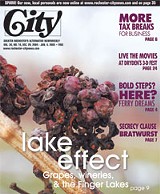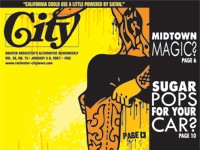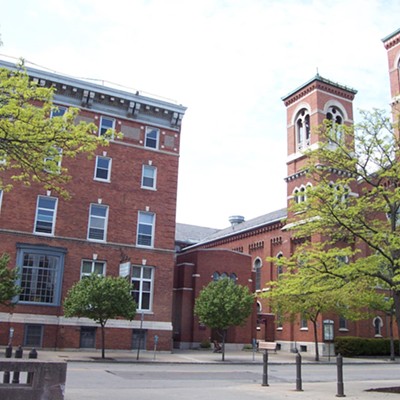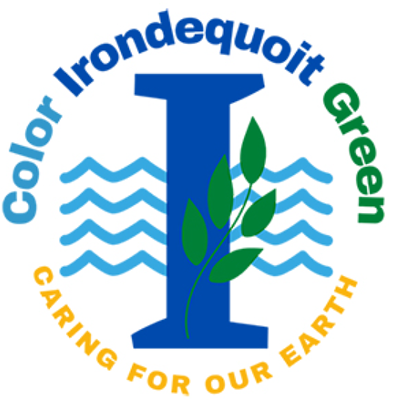[
{
"name": "500x250 Ad",
"insertPoint": "5",
"component": "15667920",
"parentWrapperClass": "",
"requiredCountToDisplay": "1"
}
]
If you stand alone in the quiet of winter among the naked vines of a vineyard, you might understand the story of the New York grape better than from savoring a glass of its best wine, or watching experienced hands pluck grapes more beautifully than a machine could.
The dark-reddish woody vines are leafless, exposed like uncovered human muscles and veins. The trellises are weathered but straight, true, and painstakingly maintained.
As if you were looking at a Van Gogh painting come to life, you can see the vulnerability and strength of the living plants, sense the struggle and purpose of the physical labor to maintain them and the deep, long-term commitment of the people who do this, either for a living or for the love of it.
The winter vineyard waits. It waits for the weather, rain, sun, tiny green shoots, leaves, and human hands. And each year, with the melting of snow here in the Finger Lakes region of New York, another new person --- or two --- is seduced into the art of viniculture, while seasoned vintners seem to become even more addicted to its way of life.
"Winemaking is a black hole for money and dreams," quips vintner John Martini, humorously but honestly, setting the mood that will permeate his entire conversation: startling candidness with a tinge of self-mockery.
John and his wife Ann's 31 years as grape growers and vintners is a story as interesting to swallow as a sip of their Anthony Road Cab Franc --- with its hint of chocolate and very light oak --- but punctuated with some killing-frost realities of the trade.
"'How did we get into this business?'" John repeats aloud, as if this is a question he's heard many times but is always looking for a new and better answer. "We weren't smart enough to stay out of it."
Our first conversation is by phone. It's a Saturday in November and, like every Saturday, John is in Union Square --- the WestVillage in downtown Manhattan --- selling his wines in a public market.
"It was 1973," he continues. "Ann and I had moved around a lot. We were in the Peace Corps, then I was in sales, so it was Long Island, Hawaii, Geneva (New York), and Baltimore. Ann was originally from Rochester; then her parents had moved to Geneva, so we knew the area.
"Other people were getting into growing grapes, and deep in my psyche I think I always wanted to grow something. My mother was raised on a farm, and when we were children we'd visit my grandparents' farm. There was an element of romance to growing grapes --- growing anything --- and it was close to Ann's parents, who encouraged us."
And," he adds as the ultimate determining factor, "we were young."
They quit their jobs and came to Upstate New York with almost nothing.
"We had $5,000 in savings," he says, "and we borrowed $2,000 more from a family member. We bought a 100-acre piece of farmland just north of Dresden, overlooking Seneca Lake, from a local farmer who was divesting himself of some his land. It was planted in vegetables at the time. We found a mobile home and put it on the property.
"The original plan was that Ann would teach and I would run the vineyard. Well, we went without electricity for nine weeks, so that meant no TV, and, well, TV's a great contraceptive, and so that led to a family, and ultimately Ann wound up staying home with the kids and managing the vineyard, while I went to work at the Cornell agricultural research labs in nearby Geneva."
"We didn't know anything about growing grapes," says John. "We asked five growers and got five different answers, asked five growers again and we had 10 answers.
"We found a winery to buy our grapes and so we started out as vineyardists, that is, growing and selling our grapes. We cleared and planted five acres. That was the spring of 1973. We got our first harvest the fall of 1975."
"Grape growing is agriculture," says John, "and agriculture challenges everything a person can possibly be: chemist, biologist, botanist, weatherman, mechanic, accountant, as well as marketing and sales."
As a mother and vineyardist, Ann had her hands full. She did the tying, trimming, and harvesting. And she hired neighbors --- folks who put their kids on the school bus in the morning, came over and worked for five hours, then went back home to meet the bus.
"We --- the older children, the neighbors, and I --- worked in the vineyard many times with one of the babies in a buggy sitting at the end of the row," says Ann. "And I delivered truckloads of grapes with my children. One time I was coming home at night with two of the children after delivering a load. I stopped along the highway by Keuka Lake to tighten some loose crates on the truck. When I got back in the truck, it wouldn't start. Those were pre-cell phone days. I think we sat there on the side of the road until 12:30 in the morning before John finally found us.
"Another time I delivered six tons of grapes to Taylor Winery, in Naples. We'd loaded the truck the night before, and I drove to Taylor first thing in the morning. I backed up to the receiving dock, and the man came out and inspected the load. The grapes had 'turned' during the night. He told me never to bring grapes like that again. That was an awful experience."
John worked fulltime in an agricultural experiment station at Cornell, then came home and did the mechanical work in the vineyard --- the spraying and tilling. Many nights the couple worked into the dark.
"In the beginning," says John, "Penn Yan kids used to get off from school at tying time to come work in the vineyards. Nowadays, they go to Myrtle Beach." With that local labor supply gone, the Martinis now use other seasonal workers.
"Pickers, whether family or hired, each have a number," says Ann, "and they put a tag with their number on it in each tray of grapes they pick; that's how they're paid. At the end of a long day, when it was dark, we used flashlights to collect those tags. Sometimes, when the crops are thin and pickers have to really look for the grapes, we pay by the hour."
They grew and sold grapes to other wineries for 14 years, and were up to 35 acres for Taylor --- until 1989, when they decided to start making their own wine. That first crop came in 1990.
The Martinis' Anthony Road Winery has grown to 14 full-time employees. Their youngest daughter, Elizabeth Kastner, manages the tasting room --- the visitor nerve center of the winery. Their son, Peter, manages the vineyard. "I couldn't get him to change a hubcap growing up," says John, "but he's doing a really good job now.
"Our winemaker is Johannas Reinhardt, from Germany. His family has been in the winemaking business since 1438 --- since before Columbus discovered America. That's pretty impressive. He believes good wines begin with close attention to the basics, that wine quality begins in the vineyard and continues through the cellar.
On Anthony Road's website, www.anthonyroadwine.com, Reinhardt says: "Mother earth gives us this great beverage. I believe in giving the wine a chance to express itself with a minimum of manipulation."
"Always hire people smarter than you," says John. "This makes you look smart."
John ticks off the list of problems New York vintners have to deal with: "There are diseases: powdery mildew, downy mildew, black rot, phomopsis, botrytis. We're more susceptible to these in New York --- with our higher humidity --- than California, Oregon and Washington."
Besides diseases, there are harsh or erratic temperatures. The reason for the plethora of wineries on Finger Lakes hillsides is the stabilizing effect of lake-water temperatures on the climate. The seasonal temperature of a large body of water is slower to change than the air temperature. The lakes keep the air temperature more stable throughout the growing year --- in the fall preventing early frosts, and in the spring preventing late freezing of tender new shoots.
But even with their proximity to water, Finger Lakes vineyards aren't guaranteed smooth sailing. Temperatures can get very cold in the deep winter. While vines can acclimate themselves to withstand sub-zero weather in January or early February, the same temperatures in late February or early March --- when the vines have begun to get used to the warmer weather --- can be damaging.
For example, while the fall season of 2003 ripened the grapes nicely after a cool, wet summer, 2004 did not provide the same conditions. Many vintners, like the Martinis, had to deal with uneven ripening by hand-sorting their grapes for color and damage. Only grapes with good color and type uniformity can be used for the varietal wines.
There's also been an image problem, with wines in general, and with New YorkState wines, specifically.
"Wine is still a mystery to many people," John says. "People think, 'Did I swirl it in the right direction in my glass?' I wish they'd forget about that stuff and just drink it."
And New York wines have had their own challenge, although, John says, "we're making strong headway."
"For years," he says, "New York had the reputation of producing fruity wines, such as concords --- which, frankly, our own (Anthony Road) vineyard was involved in, as a supplier to Taylor.
"In the 1950s and '60s, the choice was French or Italian wines. These were mostly jug wines, sweet wines, wine for wine's sake. Then in the 1960s, California's Mondavi began putting out wines like Chardonnay, Bordeaux, Merlot, and Riesling --- good food wines that people bought to go with meals. We've been 30 years behind California in this respect. We, as a state, are still proving to the world market that New York vineyards have advanced beyond this."
In this vein, in 2003 the New York Wine & Grape Foundation took its annual wine-promotion competition out of New YorkState, to Napa, California, America's definitive wine region. Five hundred wines from across New York were showcased. The judges, mostly from California and other western states, "were stunned by the diversity and quality of New York wines," states the Foundation's annual report, earning New Yorkers over 300 medals, including 32 Double Gold.
Besides disease, climate, and image, there's another challenge: Being in the wine business in New York, as well as state's treatment of the traditional 'sin businesses,' has meant, for people like John Martini, spending time in Albany and Washington, lobbying.
"Historically there's been a tax on alcohol," says John. "Going way back, it's been a sin to dance or drink."
("By the way," he says, referring to the recent presidential election results as plotted on a map of the country, "blue states drink wine, red states don't.")
"Purveyors of alcoholic beverages are taxed," says John. "We pay 18.2 cents a gallon to the state and 20 cents a gallon to the federal government --- in excise tax, just for being in business. We're a smaller-volume operation; bigger ones have to pay more.
"We've lobbied against these taxes, and for federal funds for viticulture research --- quality and varietal issues: How can we grow grapes better? We're in a world market, competing with Australia, Argentina, and Europe."
Have the Martinis realized their dreams?
"We started with nothing and, well, now we have less than nothing. We have a 'mortgage' the size of which I never imagined," says John, and he cites a dollar figure with two commas in it.
"But we have plenty of equity," he says. "The land alone is worth 10 times what we originally paid for it, plus the grapes, the buildings, the sales. Where we once grew grapes for other wineries, now everything we grow, we use, and we actually buy 40 percent of our grapes from other [local] vineyards. We make 12 or 13 different wines --- it varies; we don't produce a second vintage of a particular wine until the first has run out."
The Martinis bottle 13,000 cases a year, which, at 12 bottles to the case, extrapolates to a sales-revenue dollar figure with its own two commas and represents a tremendous achievement in growth, by any industry standards, from the original modest investment of $7,000.
The Martinis' sales break down approximately as follows: 50 percent from wholesaling to retailers, 40 percent from visitors to their tasting room, and 10 percent from farmers-market sales in New York City.
The money this represents can be misleading, cautions Ann. "We put so much back into the property, the tasting room, the equipment. The important thing --- beyond the numbers --- is that [Anthony Road's wines] have been well-received."
"Grapes are more than a selling crop," adds John. "They bring people here. We're farmers first, vintners second. If we don't grow good grapes, we won't make good wine, and people won't come."
And have people come?
"This has been a good fall," says John. "We've had 40,000 visitors to our winery this year," says John, and on a recent November Saturday, there were 600 visitors."About 25 percent of these people come from out of state, from Asia, Europe --- there's an international interest in it. And they buy gas here; they have to stay someplace; they spend money."
It would be back to Greenwich Village again the next Saturday for John. Each weekend he loads 40 to 50 cases of wine into his Ford 350 and drives to Manhattan, where he erects his 10x10 pop-up tent and sets up his wine display.
"It's my tenth year going there," he says. "I actually have help now --- a friend's daughter. I usually sell 25 to 30 cases on a Saturday. A few people buy cases, but most buy by the single bottle. When you live in New York City, you don't have a lot of extra storage room."
Thirty cases, one bottle at a time?
"I've sold as much as 49 cases [588 bottles] in one day," he says. "Part of the marketing aspect of selling wine is realizing that the buyers enjoy talking to the guy who grows it. I've got regular customers. I know about their lives; they know about my kids."
His voice becomes quieter. "I didn't get names prior to 9/11," he says. "Then after 9/11, people started to say, 'I'm Pat,' 'I'm Paul,' 'I'm Gabrielle.'
"Last week [in New York City], we did a wine-tasting fundraiser for a not-for-profit organization," he says. "It was held at a former vinegar factory on 91st Street, converted to a specialty-food store and restaurant complex. They featured New York wines. I was there to present our own wines for sampling, and I also poured samples for Fox Run," another Seneca Lake winery. "We're friendly competitors."
The day after we talked, it was on to Albany for John, for an annual wine trade show called "Harvest Fest, Pride of New York," at the DesmondHotel. Then on Monday, still in Albany, he would meet with the board of directors of the New York Wine & Grape Foundation.
Tuesday it would be back home to his not-so-black hole for money and dreams. Trellis work is the focus in December and, in January --- when for most of us, New York grape growing exists only in the form of a glass of wine shared around a warm table --- the Martini family will begin their vine trimming.
John and Ann Martini's Anthony Road Wine Company is one of almost 90 vineyards that in the last two decades have broken ground in the Finger Lakes Region. Next week: a look at how these growers and their grapes have economically impacted Upstate New York.
Speaking of...
-

Finger Lakes wines are having a moment
Dec 28, 2021 -

Calendar preview: Riding It Out
Sep 30, 2020 -

Calendar preview: Arts and About
Sep 16, 2020 - More »
Latest in Featured story
More by Rich Gardner
-

Lake effect: grapes and the region’s economy
Jan 5, 2005 -
Walking scorched earth
Aug 18, 2004 -

Walking scorched earth
Aug 11, 2004 - More »






